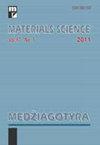自愈微生物包封混凝土对提高混凝土抗压强度的影响
IF 0.6
4区 材料科学
Q4 MATERIALS SCIENCE, MULTIDISCIPLINARY
引用次数: 0
摘要
研究微生物诱导的混凝土方解石沉淀(MICP)和裂缝填充修复结构的耐久性是本工作的目标。本研究的目的是探讨混凝土在芽孢杆菌中的自愈效果和裂缝填充修复结构的强度。用光学显微镜观察了碳酸钙颗粒的特性及其穿透水泥的性能。采用水泥砌块压力试验研究了影响微生物掺入混凝土材料愈合率的因素。结果表明,微生物具有良好的显微形态。微生物混合土具有良好的抗压性,在混合土复合材料中发挥修复作用的能力在于微生物能与混凝土紧密附着。混合土的主要断裂行为为小孔破裂,未观察到混合土基质的宏观损伤和大孔破裂。巴氏芽孢杆菌表现出比枯草芽孢杆菌更好的潜力,可以作为混凝土中的自愈剂。实验结果证明,巴氏杆菌产生一种胶状粘接剂来填充和修补裂缝。本研究通过设计不同密度的混凝土,形成具有不同抗压强度、透水性和吸水率的立方体,进一步观察芽孢杆菌填充裂缝和防止水渗透的能力。结果表明,与相同性能的对照无菌样品相比,粗集料实验样品的抗压强度提高了60%,细集料实验样品的抗压强度降低了36%。表明在骨料中使用细菌的样品密度更大,多孔性更少。实验证明,利用微生物可以实现混凝土材料的自愈能力,填充孔隙,建立功能效果。本文章由计算机程序翻译,如有差异,请以英文原文为准。
The Effect of Self-Healing Microorganism-Encapsulating Concrete on Enhancing Concrete Compressive Strength
Investigating microbially induced calcite precipitation (MICP) of concrete in bacillus and the durability of crack-filled repair structures were the goals of this work. The purpose of this study was to investigate the self-healing effect of concrete in bacillus and the strength of crack-filled repair structures. The characteristics of calcium carbonate particles and the performance of those penetrating cement were observed using optical microscopy. The cement block pressure test was used to study the factors affecting the healing rate of concrete materials mixed with microorganisms. The results showed that the microorganisms had good microscopic morphology. Microbial mixed soil had good compression resistance, and the ability to play a repairing role in mixed soil composite materials was that organisms could be attached to the concrete tightly. The main fracture behavior of the mixed soil was a small-hole rupture, while no macroscopic damage or large-pore ruptures were observed in the mixed soil matrix. Sporosarcina pasteurii exhibited better potential than Bacillus subtilis and could act as a self-healing agent in the concrete. The test results proved that S. pasteurii produced a colloidal adhesive to fill and repair cracks. The study designed concrete of different densities to create cubes having different compressive strengths, water permeability, and water absorption to further observe the ability of Bacillus to fill the cracks and prevent water penetration. The results showed a 60 % increase in the compressive strength of the coarse aggregate experimental sample and a 36 % decrease in the compressive strength of the fine aggregate experimental sample, relative to the same properties in the control sterile sample. Samples indicating the use of bacteria in the aggregate were denser and less porous. It was proven that the use of microorganisms could achieve self-healing ability in concrete materials, fill up pores, and establish functional effects.
求助全文
通过发布文献求助,成功后即可免费获取论文全文。
去求助
来源期刊

Materials Science-medziagotyra
工程技术-材料科学:综合
CiteScore
1.70
自引率
10.00%
发文量
92
审稿时长
6-12 weeks
期刊介绍:
It covers the fields of materials science concerning with the traditional engineering materials as well as advanced materials and technologies aiming at the implementation and industry applications. The variety of materials under consideration, contributes to the cooperation of scientists working in applied physics, chemistry, materials science and different fields of engineering.
 求助内容:
求助内容: 应助结果提醒方式:
应助结果提醒方式:


